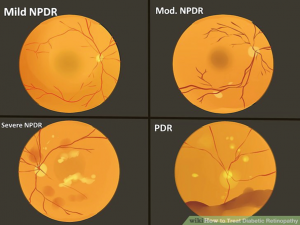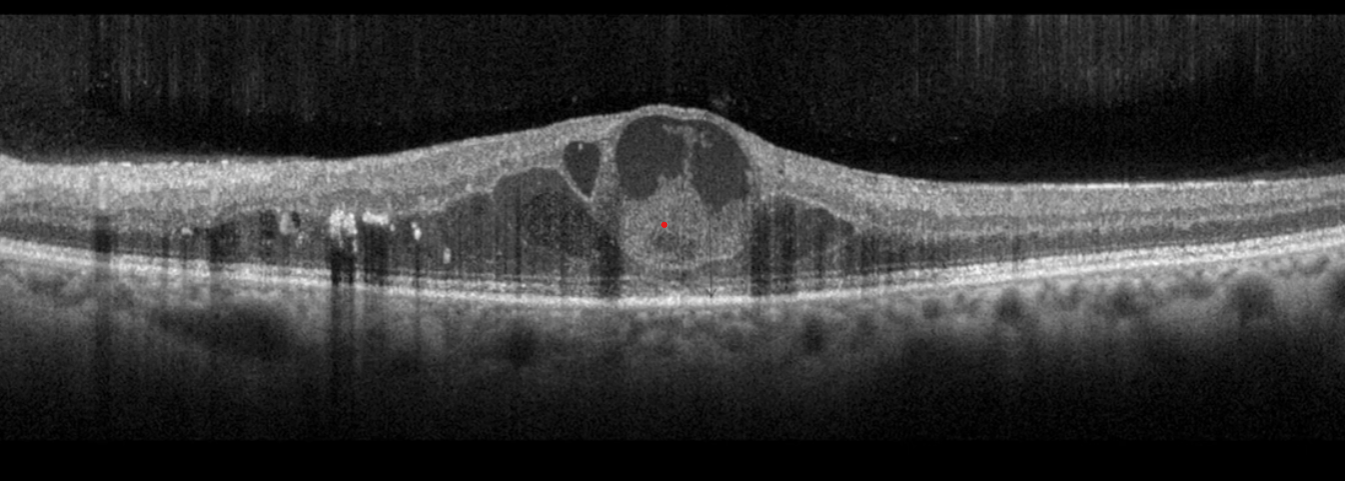A noted previously, my diabetes was first identified during a visit to the optician. My GP, besides prescribing treatment, also referred me to ophthalmology to monitor my eyes. My nearest clinic is the Macula Centre in Bradford, where I have now been several times.
At every consultation there is a three step process. First you get to see a couple of technicians who check your prescription, eyeball pressure and drop liquid in your eyes to dilate (cyclopentolate solution) your pupils. Next up is retinal imaging and scanning. Finally the ophthalmologist will take a look at your results and your eyes to decide if anything needs to be done.
Diabetic retinopathy
The issue with elevated blood glucose levels is that the capillaries, very fine blood vessels, can burst releasing fluid into the retina. This becomes visible as the yellow spots visible in the images below. This condition is know as diabetic retinopathy.
The images below show the progression of of diabetic retinopathy (DR) from Vanusha et al (2021). NP – non-proliferative, P – proliferative.

If left untreated this damage will eventually lead to loss of vision and eventually blindness. Getting DR diagnosed as early as possible is important as, like most disorders, it is easier to treat in the early stages. Getting blood sugar under control is crucial in the treatment of DR. Even when treated the condition may lead to the development of macular oedema (edema in American English). Basically a build up of fluid in the part of the eye known as the macula. This is the part of the eye that process what you see directly in front of you. The macula lets you see small details and focus on very specific aspects of what you’re looking at. The image below shows a retinal scan showing macula oedema. I took this picture from the original scan that the opthalmologist showed me. This was my right eye in September 2025. The green line is the centre of the eye, the bulge to the right is the oedema. Macula oedema can affect you vision particularly when reading or trying to study fine details. It can also make your vision blurry. To date mine hasn’t got to that stage, hopefully it never will.

In my case, my diabetes is under control, retinopathy is not progressing but I clearly have some oedema. The consultant ophthalmologist recommended treating with an injection into my eye! The injection technique involves preparing the eye with sterile washes, dilating drops and local anesthesia. The eyelids are then clamped open and a special applicator to inject the steroid implant through a self-sealing scleral (white of the eye) tunnel into the eye’s vitreous cavity. There are two types of steroid implant used in the UK, Ozurdex® and Iluvien® being the brand names. Ozurdex® (which is what I will be getting) consists of microencapsulated dexamethasone (the steroid). The micro-capsules break down over time to provide a continuous release of steroid lasting around 3 months. Illuvien, active ingredient fluocinolone acetonide, is similar but can have an effect for up to 36 months.
Can’t say I’m really looking forward to it (pun intended), but it is a better option than steadily deteriorating vision.
Update:
I’ve had the inection. Whilst it was an unpleasant sensation it was painless. The process does involve quite a few drops going into the eye, mainly for anaesthetic purposes, but also iodine solution to prevent infection. The sensation of the needle penetrating the tough sclera (white of the eye) and through into the vitreous body was quite disconcerting as was the very loud click as the injection was made. The process itself was over in seconds and off I went. All the drops in the eye made my vision a bit blurred and very light sensitive for a while. I was told, as I was waiting for the injection, that it was recommended to bring sunglasses when having the procedure. Bit late to tell me then!
I’ve not had any problems other than the implant injected keeps appearing as a “floater” in my vision. This was a bit distracting at first but I soon got used to it. The injection site was also a little tender for a day or two after the anaesthetic wore off. I’ll update again in future posts.


